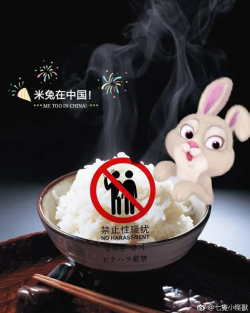Rice bunny
来自China Digital Space
mǐtù | 米兔

Code word for #MeToo, the global feminist movement in which women are breaking the silence about sexual harassment. Sounds like "me too."
The #MeToo movement, which started in the U.S. in 2017 and spread globally following a New York Times report on serial sexual harassment and rape by Hollywood producer Harvey Weinstein, did not gain momentum in China at first, due to censorship and other social and cultural factors. A 1998 rape case at Peking University initially became a rallying cry for the movement’s supporters, but student Yue Xin, who wrote an open letter about the case, was harassed by school authorities, and her letter was censored online. Then in January 2018, Luo Xixi posted to Weibo about how her former professor, Chen Xiaowu, had harassed her and many other female students. With this public accusation, Chen was suspended by his university, and #MeTooinChina took off.
The rice bunny was born of necessity, as the censors continued chasing down hashtags related to the #MeToo movement. More than cloaking text in a protective layer, the rice bunny allowed feminists to voice their support for each other with emojis (🍚🐰), photos, and art.
Zhou Xiaoxuan, a young screenwriter better known as Xianzi, become the face of the "rice bunny" movement in July 2018, when she went public about the harassment she had suffered at the hands of Zhu Jun, one of China’s most prominent TV hosts, when she was an intern four years prior. Xianzi had her day in court on December 2, 2020, with supporters marching with her to and from the courthouse. She is still awaiting the verdict as of March 12, 2021. Browse photos from the day of the hearing compiled by CDS Chinese.




